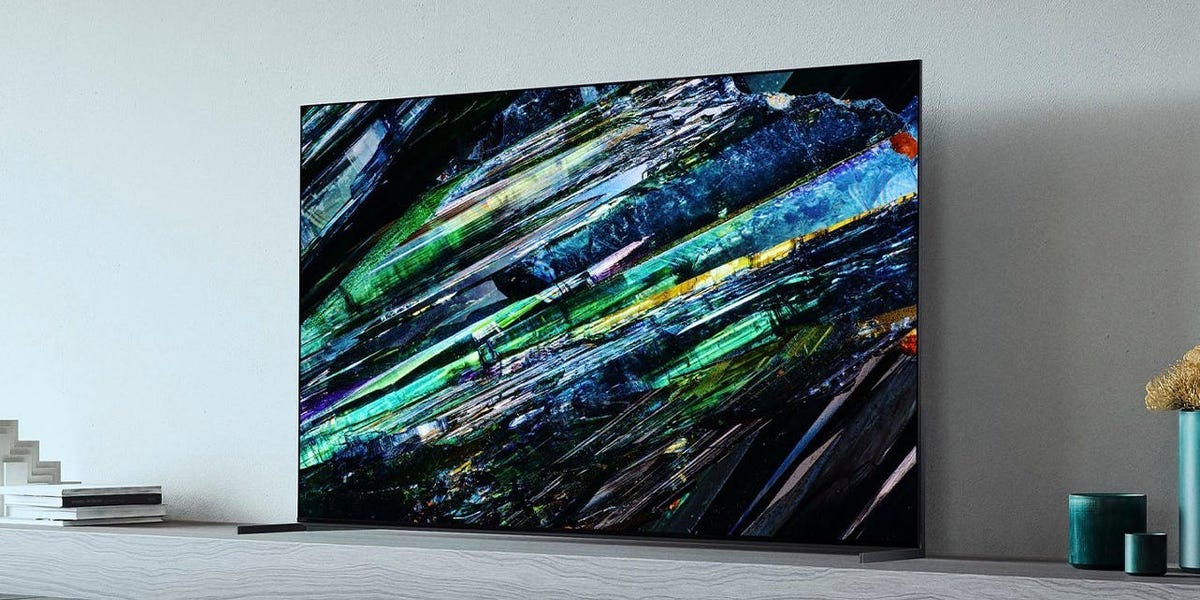When you buy through our links, Business Insider may earn an affiliate commission. Learn more
For a long time, 60- and 65-inch displays were the pinnacle of the big-screen TV market. But in recent years, 75-inch TVs have hit the mainstream, with entry-level and high-end models from every major brand. The best 75-inch TVs can deliver an immersive viewing experience, and they’re ideal for bigger living rooms where you may need to sit farther from your display.
Our team has been reviewing home entertainment products for over a decade, and we’ve selected the best 75-inch TVs based on a combination of hands-on testing and expert research. Our top pick is the Samsung S89C, which has unrivaled contrast and color performance for the money. But buyers who want a more budget-friendly 75-inch TV should check out the Hisense U6K, which offers impressive image quality for a typical sale price under $800.
Below, you can find our six recommendations for the best 75-inch TVs. We’ve also highlighted picks geared toward midrange and premium performance and buyers who want an extra-bright or 8K display.
Note: LCD-based TVs (LED, QLED, Neo QLED) are often manufactured in a 75-inch screen size, but OLED displays are instead sold in a slightly larger 77-inch size. For that reason, we’ve included 77-inch OLED TVs in this guide.
Our top picks for the best 75-inch TVs
Best overall: Samsung S89C 4K OLED TV – See at Best Buy
Best premium option: Sony A95L 4K OLED TV – See at Amazon
Best budget model: Hisense U6K 4K QLED TV – See at Amazon
Best midrange display: Hisense U7K 4K QLED TV – See at Amazon
Best for brightness: TCL QM8 4K QLED TV – See at Amazon
Best 8K display: Samsung QN900C 8K QLED TV – See at Amazon
Best overall
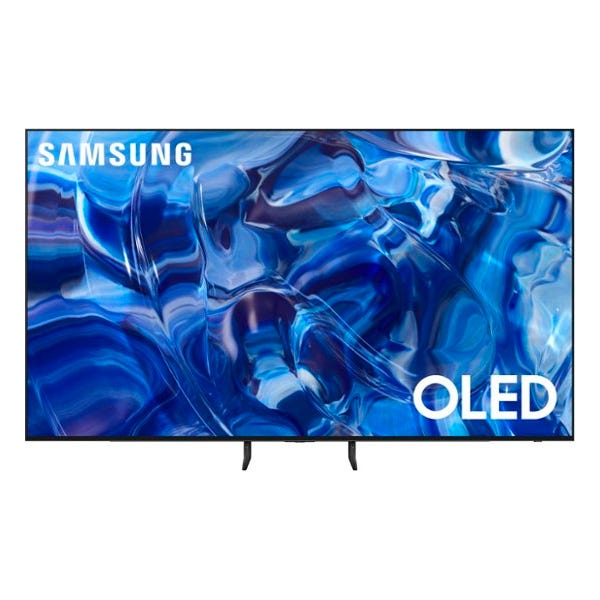
Samsung 77-inch S89C 4K OLED TV
The S89C is a slight variation of our current favorite TV overall, the S90C. It delivers the same incredible contrast and quantum dot color performance but comes with attachable feet for a stand rather than a pedestal design. The 77-inch S89C is currently $700 less than its S90C counterpart, making this model a steal for an extra-large OLED like this.
The Samsung S89C is a Best Buy-exclusive version of the brand’s S90C, which is our top pick for the best TV you can buy. The S89C has the exact same display as the S90C, but it uses a different kind of stand with left and right feet rather than a pedestal to rest on. And unlike the S90C, the S89C is only available in a 77-inch model.
So, what gives the 77-inch S89C the top spot in this guide versus the 77-inch S90C? It comes down to price. The S89C is sold for as much as $700 less than its S90C counterpart. Though the S90C’s stand is nicer, we don’t think it’s worth the extra money. When it comes to TVs in the 75- to 77-inch range, the S89C delivers unbeatable value.
The S89C uses a QD-OLED panel, which allows it to deliver pixel-level contrast control and high color volume. Black levels are deep and disappear into a dark room, while colors are rich and bright. We measured a peak brightness of about 1,000 nits on the S90C, and since both TVs use the same panel, that’s what you can expect on the S89C.
This gives HDR10 and HDR10+ content brilliant highlights and allows the display to produce more vivid HDR images than an OLED TV without quantum dots, like LG’s models. On the downside, the S89C doesn’t support Dolby Vision, a popular HDR format used on many streaming services. Dolby Vision can give a TV more detailed guidance on how to display HDR images accurately, but improvements with Dolby Vision versus HDR10 are often extremely subtle, so we don’t think this omission is a dealbreaker.
Samsung’s smart TV interface is solid, with access to all of the best streaming services, but navigation can sometimes be a little sluggish. On the plus side, the interface includes a Gaming Hub with access to the Xbox Game Pass app. This allows Game Pass members to stream Xbox games without a console. The S89C also supports a fast 144Hz refresh rate when paired with a PC to deliver smooth gameplay.
If you dislike the S89C’s left and right feet, we recommend the 77-inch S90C as the next best alternative. But outside that design difference, they’re the same TV, and the S89C’s price-to-performance ratio is simply unrivaled at this size.
Read our Samsung S90C 4K TV review (S89C with a pedestal stand).
Best premium option
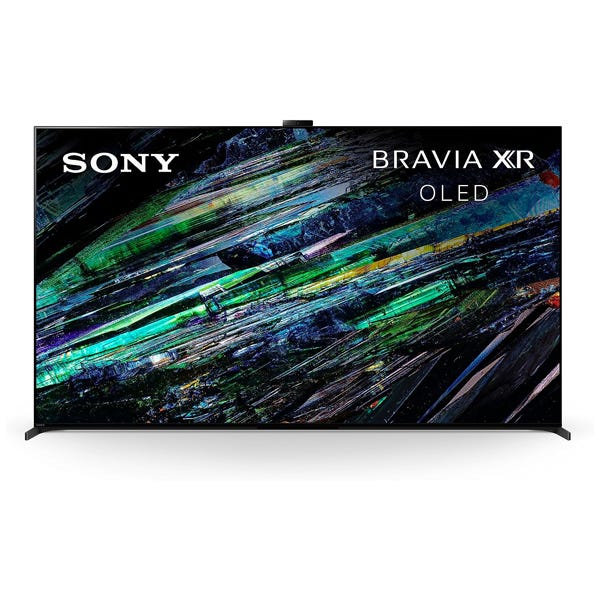
Sony 77-inch A95L 4K OLED TV
The Sony A95L is the best 77-inch high-end TV there is. It’s expensive, but the display’s QD-OLED screen offers the most impressive image performance we’ve seen. We also love its premium design and convenient Google TV interface.
Sony’s A95L OLED is the ultimate display for big home theater enthusiasts who want a 77-inch TV. Bar none, this is the most impressive TV we’ve tested, but it’s also one of the most expensive.
Like our top pick in this guide, the Samsung S89C, the Sony A95L uses a QD-OLED panel with an infinite contrast ratio and high color volume. But while the S89C tops at around 1,000 nits of peak brightness, we measured a max of 1,500 nits on the A95L in its “Professional” picture mode, which offers the most accurate default image. That’s 500 nits more than Sony’s previous model in this series, the A95K, and the brightest measurement we’ve recorded on an OLED TV.
The high brightness works in tandem with the OLED screen’s pixel-level contrast to deliver stunning HDR images. Some HDR videos are graded for a peak luminance above 1,000 nits, so the A95L’s ability to go over that number allows it to display bright highlights more accurately. This is especially true when watching Dolby Vision material since these videos give the TV specific guidance on how to scale color and contrast to best match the display’s capabilities.
Sony’s picture processing also helps to give the TV unrivaled image accuracy and even lower quality sources from cable, indoor TV antennas, and YouTube upscale nicely. And like all OLED TVs, the picture quality doesn’t degrade when you sit to the side of the screen. Given its premium price, it’s also no surprise that the A95L has some nice design flourishes, like a backlit remote, an adjustable stand that supports three orientations (high, low, and narrow), and a webcam for video calls and gesture controls.
Gamers get full 120Hz support when paired with a PS5 or Xbox Series X console, but only two of the TV’s HDMI ports have the required bandwidth for this feature. There’s also no 144Hz mode for PC gaming, which is something that Samsung, TCL, and Hisense offer on many of their top TVs. Still, it’s difficult to find much fault with the A95L, given how incredible it looks. Most people are better off saving money with any of our other best 75-inch TV picks, but this is the high-end TV to buy if you don’t have any budget restrictions.
Best budget model
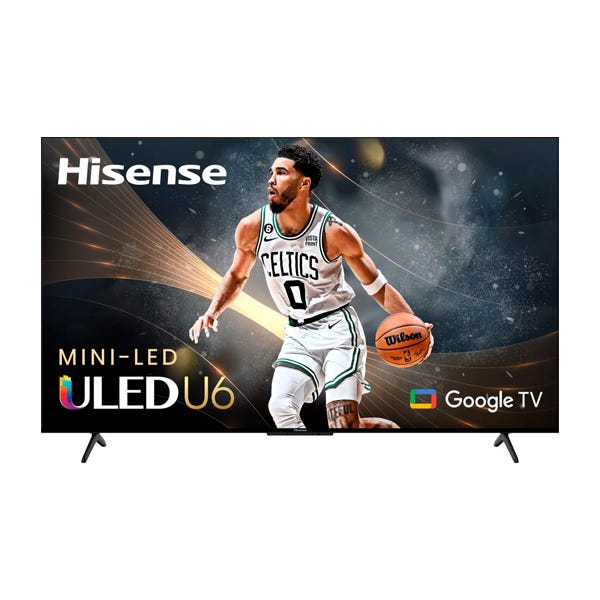
Hisense 75-inch U6K QLED 4K TV
The Hisense U6K offers a rare combination of features at such a low price point. It’s the most affordable 75-inch Mini LED on the market, and it delivers great color and contrast performance for the money.
Hisense’s U6K is the best 75-inch TV you can buy on a budget. For a sale price that often dips below $700, there isn’t anything comparable in its class. All of the 75-inch TVs that are available for less money will deliver noticeably lower contrast and a narrower range of colors.
To achieve its high contrast performance, the U6K uses a Mini LED backlight with local dimming, a combination we haven’t seen in other TVs in this price range. This allows the screen to dim across small areas, so dark elements of an image can remain dark, while only bright areas get bright. When we reviewed the U6K, we did notice that black levels weren’t as deep and uniform as you’d find on pricier displays, but the TV delivered impressive picture quality for the money.
Colors are also vivid thanks to the display’s quantum dots, and the U6K can achieve a peak brightness of 600 nits. For the best HDR performance, we recommend finding a set that can get closer to 1,000 nits or higher, but 600 is still bright enough to see the benefits that high dynamic range videos can provide. The U6K supports every major HDR format, including Dolby Vision, which Samsung TVs lack.
But while the TV looks great when viewed from a centered position, colors and contrast fade if you sit off to the side of the display. This is a common drawback for many budget and midrange TVs that use LED and QLED panels, so we recommend opting for an OLED model if that’s a dealbreaker. The U6K’s smart TV navigation speed also leaves a bit to be desired, and its 60Hz panel can’t support 120Hz gameplay on a PS5 or Xbox Series X. But again, these are expected tradeoffs for a budget-friendly set like this.
Ultimately, the U6K is geared toward buyers who want an affordable 75-inch TV that doesn’t sacrifice genuine HDR capabilities, and in that sense, it’s a winner.
Read our Hisense U6K 4K TV review.
Best midrange display
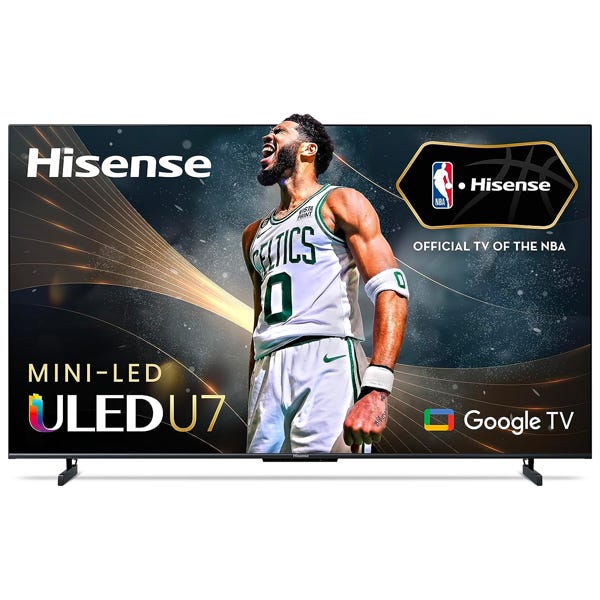
Hisense 75-inch U7K QLED 4K TV
Hisense’s U7K Google TV has excellent brightness, voice controls, and full 120Hz compatibility with PS5 and Xbox Series X.
The U7K is Hisense’s midrange 4K QLED TV. Like the cheaper U6K, it uses a Mini LED backlight with local dimming and quantum dots, but the U7K delivers an even brighter image and deeper black levels. It also makes the jump from a 60Hz panel to a 120Hz screen, which gives this model better gaming performance.
During our review process, the U7K impressed us with its vibrant HDR images, and it offered noticeably better black-level performance than the U6K and other cheaper QLEDs. We also didn’t encounter any major blooming (when halos appear around bright objects) in dark scenes, but shadow detail wasn’t as good as what we’ve seen on more expensive TVs.
Like other similar QLEDs, viewing angles are lacking, so you’ll want to sit centered to the screen to get the best performance. And though the U7K’s Google TV interface has many apps, it’s not the snappiest version of this OS we’ve used. Eagle-eyed viewers might also spot minor uniformity issues and occasional brightness fluctuations from scene to scene, but these flaws are minor compared to the TV’s many strengths.
It’s not perfect, but the U7K is the best 75-inch TV for people who want upper-midrange performance without breaking the bank. It has a list price of about $1,200, but it’s often sold for $900, which is a fantastic value.
Read our Hisense U7K 4K TV review.
Best for brightness
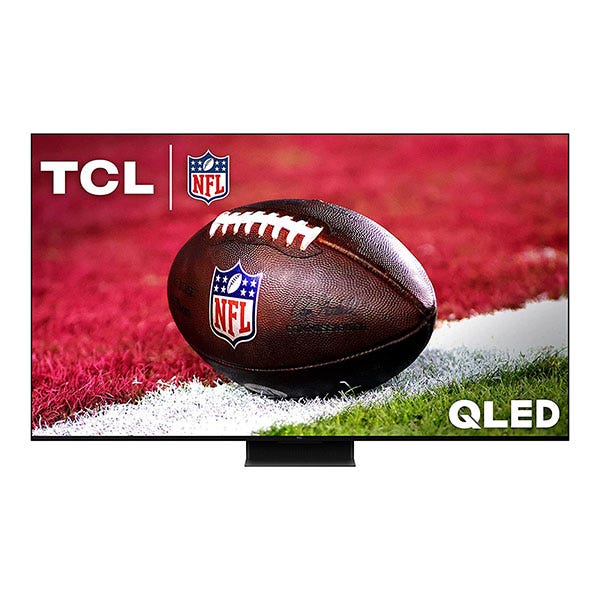
TCL 75-inch QM8 QLED 4K TV
TCL’s QM8 is the brand’s flagship 4K QLED TV. It’s capable of 2,000 nits, which makes it one of the brightest TVs you can buy.
Shoppers who want a bright 75-inch TV to deliver great daytime viewing and intense HDR performance should have the TCL QM8 on the top of their list. This TV can hit over 2,000 nits, which puts it among the absolute brightest displays on the market.
Like the Hisense U7K, this TCL display uses a Mini LED backlight with local dimming, quantum dots, and a fast 144Hz refresh for PC games. But this model has more dimming zones, which enables it to deliver even more precise control over its light output. When reviewing the TV, we were blown away by the display’s deep black levels and vibrant colors.
Though the QM8’s contrast control still can’t match an OLED, it gets remarkably close while offering a brighter image. This makes it an especially good choice for people who like to watch TV during the day since you can pump up the brightness to overcome ambient lighting and sunlight.
However, while the screen’s anti-reflective coding works incredibly well in most cases, it uses a filter that can cause a subtle rainbow effect when hit with light from certain angles. (This rainbow streaking is also common on many Samsung QLED TVs and shows up most when overhead lighting is near the screen.) If that’s the case for your setup, you might want to consider a different model on our list. And though viewing angles are a bit better than the cheaper QLED TVs we recommend, they’re still not as good as what you get with an OLED.
Read our TCL QM8 4K TV review.
Best 8K display
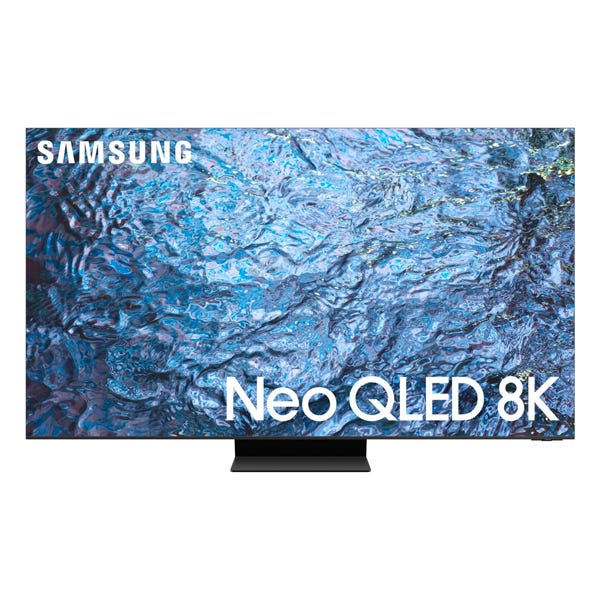
Samsung 75-inch QN900C QLED 8K TV
Though the benefits of 8K resolution are hard to see, there’s no denying how incredible the QN900C looks, especially if you get an extra-large model. Outside of its high resolution, the QN900C is also one of the brightest TVs you can buy.
If you’re going to buy an 8K TV, 75 inches is the smallest size you should consider. This is because the benefits of 8K resolution are only noticeable when you sit close to an extra-large screen. When it comes to 75-inch 8K TVs, the Samsung QN900C is easily one of the best.
The QN900C’s 8K display offers four times the total number of pixels that you’d get on a 4K TV. But even more impressive than its resolution is the display’s excellent contrast and brightness capabilities. The TV has a Mini LED backlight with fantastic local dimming performance. This results in some of the best black levels we’ve ever seen outside an OLED TV and one of the brightest panels you can buy.
The 75-inch QN900C’s 8K panel delivers sharp images, but the benefits over 4K are subtle.
Steven Cohen/Business Insider
During our evaluation, we measured a peak of about 2,300 nits in Filmmaker Mode, which is the setting that offers the most accurate image out of the box. The QN900C’s viewing angles are also much better than a typical QLED TV, so the image doesn’t degrade much when you sit off to the side of the screen.
However, as impressive as the QN900C is, we still don’t think most people need an 8K TV. Even on a large screen like this, the perks of 8K are hard to notice unless you sit very close to the display. And virtually everything you’ll watch on the TV will just be 4K, HD, or SD sources that get upscaled to 8K since native 8K content is virtually nonexistent.
Don’t get us wrong, this is an incredible-looking TV, but its impressive picture quality mostly stems from its use of a Mini LED backlight and quantum dots rather than its resolution. Still, if you’re dead set on jumping to 8K, the QN900C is a top choice, and it’s one of the best Samsung TVs you can buy.
How we test 75-inch TVs
We evaluate key image features and use various demo clips to test 75-inch TVs.
Steven Cohen/Insider
We picked the best 75-inch TVs through a combination of hands-on reviews and research. We’ve been covering the home entertainment product industry for over 10 years and used that expertise to inform our testing parameters and requirements.
When reviewing displays, most companies ship us their 65-inch options since that’s the industry’s flagship standard. However, overall performance typically stays the same across larger sizes from 50 inches and up when evaluating a specific TV model. For example, a 77-inch Sony A95L OLED and a 65-inch A95L OLED have the same specifications. The only major difference is the panel’s size.
However, some QLED TVs with local dimming, like the TCL QM8, have more dimming zones in larger screen sizes than smaller ones. This can cause slight differences in contrast performance when comparing a 75-inch model to a 65-inch one, but not enough to change our overall takeaway. In rare cases, some TVs do have more dramatic differences in features and design across sizes. Still, we consider those changes when recommending displays and note those instances when applicable.
When we test TVs, we evaluate picture clarity, color quality, contrast performance, peak HDR brightness, gaming features, navigation speed, off-axis viewing, and general value. To measure brightness, we use an X-Rite iDisplay Plus colorimeter in combination with test patterns on the Spears & Munsil UHD HDR Benchmark 4K Blu-ray disc.
Test patterns are great for objective measurements, but watching real-world content is the only way to fully evaluate how a TV looks. We sample plenty of shows and movies to see how a display performs in an average setting. Part of our evaluation involves watching the same assortment of scenes on each TV we review to compare performance. Sequences are chosen to show off HDR highlights, shadow detail, black levels, upscaling, and motion. We also mix up the quality of our material to see how a TV handles 4K, 1080p, and standard definition (SD) programs from Blu-ray discs, streaming services, and cable TV.
75-inch TV FAQs
You can sit farther away from a 75-inch TV while still seeing the benefits of 4K resolution.
Steven Cohen/Business Insider
Is 75 inches a good TV size?
75 inches is an excellent size for anyone who wants an extra-large TV to fill a big space or offer an especially immersive experience in a smaller room. Many of our picks for the best 4K TVs and best OLED TVs are sold in the 75/77-inch screen class, so you have plenty of options.
If you don’t have the space for a 75-inch 4K TV but still want many models to choose from, check out our guides to the best 65-inch TVs and 55-inch TVs for our top recommendations for those sizes.
How much should you spend on a 75-inch TV?
The best 75-inch TVs can range from around $600 to more than $3,000, depending on the performance class you choose.
Budget-friendly 75-inch QLED TVs, like the Hisense U6K, are sometimes on sale for as low as $650, and if you’re willing to sacrifice contrast and color performance, you can find some cheaper 75-inch TVs for as little as $500. Midrange QLED options with higher brightness typically sell for $800 to $1,300, while high-end models cost as much as $2,500.
If you want an OLED TV model, which are made in 77 inches rather than 75, you’ll need to pay a bit more. The cheapest 77-inch OLED TVs start at around $1,800, while premium options cost as much as $5,000.
Should you buy a soundbar for your 75-inch TV?
Even the best 75-inch TVs have mediocre built-in audio performance. Companies often build their displays with small speaker drivers to keep costs down and screens slim, and this can lead to a lack of bass and overall clarity. To get more dynamic and crisp sound quality, we recommend purchasing a separate soundbar or surround sound system, particularly one with Dolby Atmos support.
Check out our guides to the best soundbars and best Dolby Atmos soundbars to see our top recommendations.
How far should you sit from a 75-inch 4K TV?
A large screen size of 75 inches enables you to sit farther away from your display while still getting an immersive experience. To start seeing the benefits of 4K resolution with an optimal field of view, the recommended distance is about one to 1.5 times the size of your TV.
So, for a 75-inch 4K TV, you should aim to sit between 6.25 and 9.38 feet from your screen.
However, for your eyes to be able to make out the full benefits of a 4K resolution image, you’d need to sit just 4.9 feet away from a 75-inch screen. Of course, most people don’t sit that close to their displays, and you can still enjoy a 75-inch 4K TV from a greater distance.
